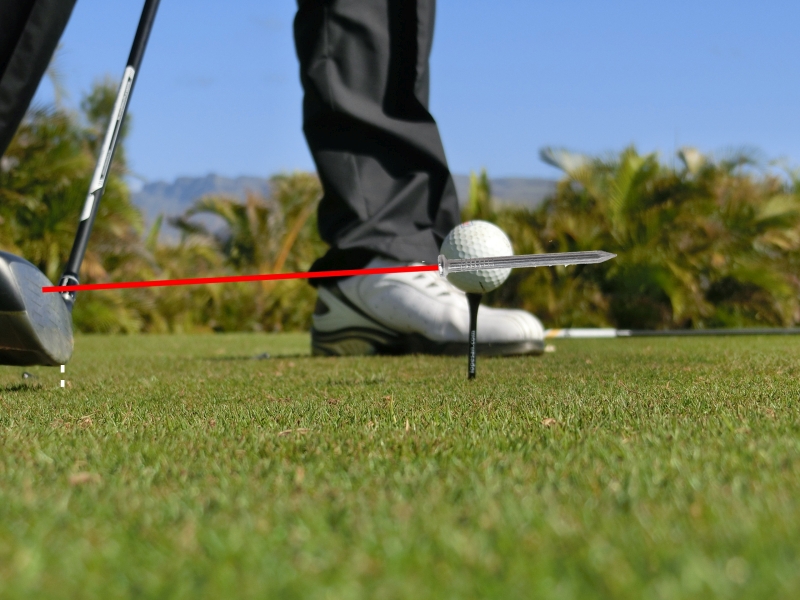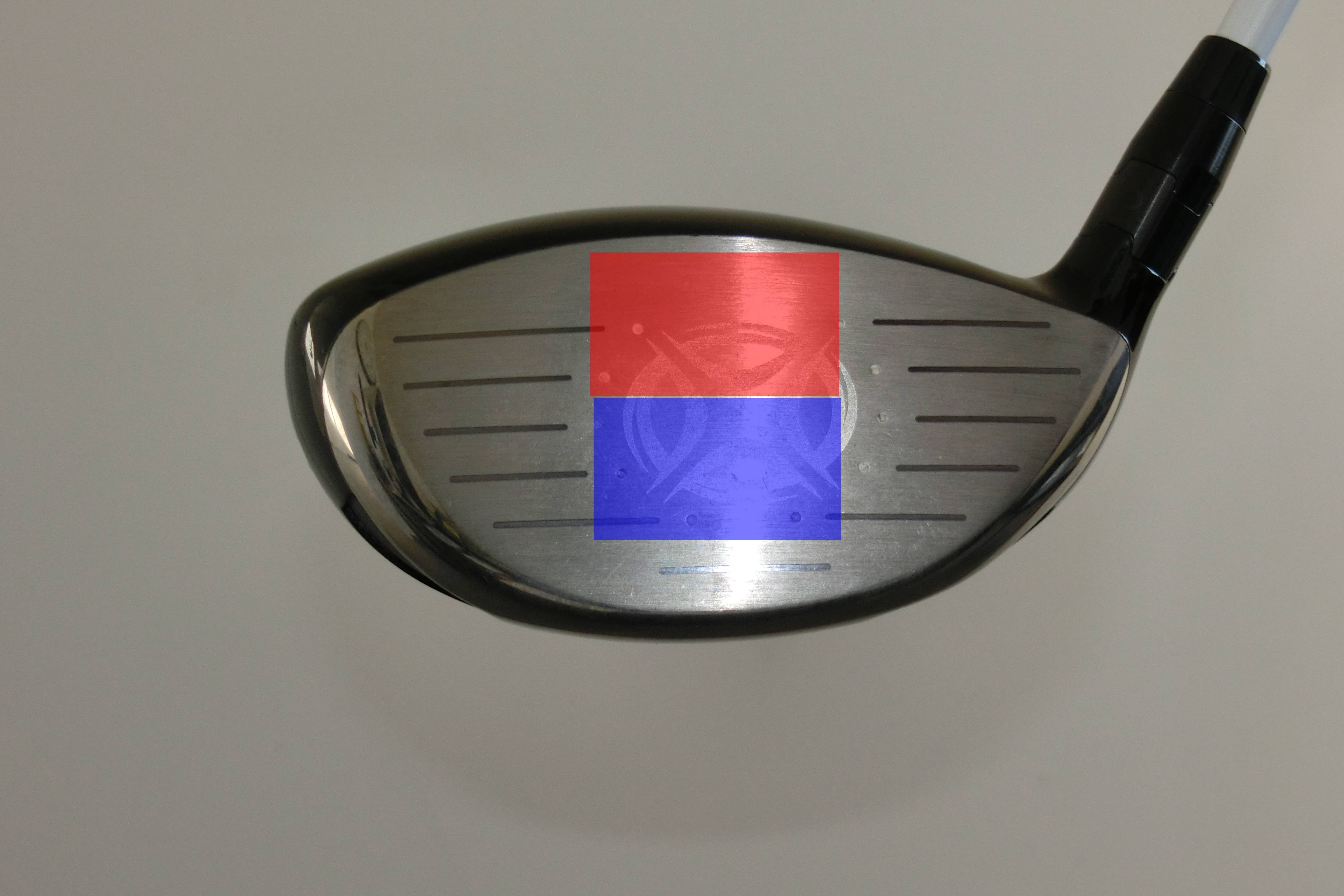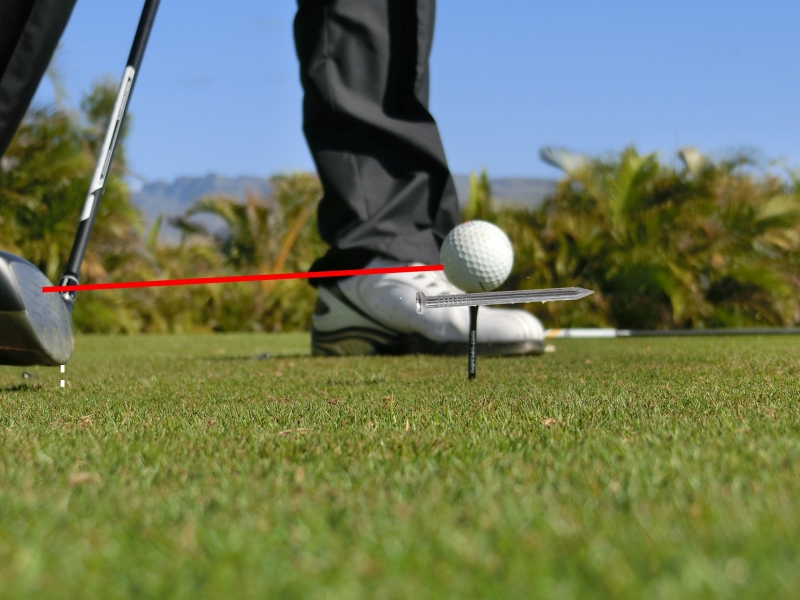Instruction
Use the Nail Drill to increase your driving distance

In my article “How I hit drives 56 yards farther with just one adjustment,” I discussed the role angle of attack plays in helping optimize launch and spin of the ball for more distance. In a two subsequent articles, “Practice the Nail Drill to improve your swing without thinking about it” and “Nail your swing path with this drill,” I discussed how the intention of how you hit the ball can have an effect on your technique.
In this article, I combine the two ideas.
Angle of attack, or AoA, relates to whether your club hits up or down on the ball at impact and is measured in degrees. Having a more positive, or upward angle of attack with a driver can lead to a greater ability to apply minimal spin loft while still launching the ball high in the air. Minimal spin loft is important, because it creates maximum compression of the ball and can lead to more distance.
While a lot of average golfers can have an AoA of 5-8 degrees down with a driver, LPGA Tour players (a good comparison for most golfers, as they usually have similar swing speeds of around 90-95 mph) usually have an AoA of about 3 degrees up. Long drive champions have been known to have AoA’s as high as 8 degrees up, and one of my attempts in the driving distance article managed to reach almost 12 degrees — although I wouldn’t recommend going this extreme unless you are trying to compete for long drive.
One of the simplest ways to instinctively increase your AOA with the driver is by imagining a nail through the ball, angled slightly towards the sky, as shown.
In order for the club to go from low to high through impact, you will need to use a taller tee than normal. Getting the tee height set so that half of the ball is above the top of the clubhead is a good start, but the more you hit up on it, the higher a tee your will need. I personally use a ridiculously high tee.
Get set up in a way you feel you could hammer the nail through the ball, which should include:
- A slightly more forward ball position.
- A spine tilt away from the target, which for a right-handed golfer means putting your right shoulder lower than the left at address.
- A feel at address that you are looking more at the underside of the ball.
Don’t sky it
One thing is for certain, a steep (downward angle of attack) with a high tee will result in pop-ups, which is why most amateurs like to tee it low. So if you that find you are skying shots, make sure to work on getting the angle of attack more positive, or upwards.
Another thing to watch out for is your impact location on the driver face. Lots of people usually start hitting shots a little lower on the face when they make a more positive angle of attack. Ideally, we want to hit in the red zone, or “hot zone” of the club face, which is shown in the image below.
While the red zone may not be the exact sweet spot, or CG center of the club face, impacting shots in that area usually leads to more distance because of something called vertical gear effect. When you hit the ball in the red area, vertical gear effect causes the ball to have a higher launch angle and less spin — a recipe for more driver distance. While impacting the ball above the sweet spot negatively affects ball speed, another factor of distance, it is usually only a small penalty because of how forgiving today’s drivers are.
Trust me, it’s worth the tradeoff.
One good image to move the strike higher on the face is to visualize a nail beneath the ball. You can still hit the ball with the path and face angle you desire, but think about the nail being lower than the ball so the club swings closer to the ground as it is moving upward. Be careful not to hit the ground at all, because you certainly don’t want to hit a “drop kick,” which will cost you distance.
The above photo shows the center of mass of the club being directed towards the nail, so the “hot zone” of the face hits the ball instead.
By thinking of the nail below the ball like this, and still angled upward, you will direct the sweet spot of the club slightly lower through impact. This will cause the ball to be hit higher on the face and almost always creates more optimal launch conditions.
Don’t over-do it, though. It is possible to “sky” or “pop up” a ball, even with an upward angle of attack.
Want to check your progress? Use a dry erase marker and draw a dot on the back of the ball. This will leave an imprint on the club face at impact so you can check to see if you have struck your shot in the red zone.
Editor’s Note: Adam discusses these principles and much more in his book, “The Practice Manual: The Ultimate Guide for Golfers,” which is available on Amazon.
- LIKE83
- LEGIT18
- WOW9
- LOL239
- IDHT4
- FLOP270
- OB244
- SHANK308
Instruction
Clement: Laid-off or perfect fade? Across-the-line or perfect draw?

Some call the image on the left laid off, but if you are hitting a fade, this could be a perfect backswing for it! Same for across the line for a draw! Stop racking your brain with perceived mistakes and simply match backswing to shot shape!
- LIKE0
- LEGIT0
- WOW0
- LOL0
- IDHT0
- FLOP0
- OB0
- SHANK1
Instruction
The Wedge Guy: The easiest-to-learn golf basic

My golf learning began with this simple fact – if you don’t have a fundamentally sound hold on the golf club, it is practically impossible for your body to execute a fundamentally sound golf swing. I’m still a big believer that the golf swing is much easier to execute if you begin with the proper hold on the club.
As you might imagine, I come into contact with hundreds of golfers of all skill levels. And it is very rare to see a good player with a bad hold on the golf club. There are some exceptions, for sure, but they are very few and very far between, and they typically have beat so many balls with their poor grip that they’ve found a way to work around it.
The reality of biophysics is that the body moves only in certain ways – and the particulars of the way you hold the golf club can totally prevent a sound swing motion that allows the club to release properly through the impact zone. The wonderful thing is that anyone can learn how to put a fundamentally sound hold on the golf club, and you can practice it anywhere your hands are not otherwise engaged, like watching TV or just sitting and relaxing.
Whether you prefer an overlap, interlock or full-finger (not baseball!) grip on the club, the same fundamentals apply. Here are the major grip faults I see most often, in the order of the frequency:
Mis-aligned hands
By this I mean that the palms of the two hands are not parallel to each other. Too many golfers have a weak left hand and strong right, or vice versa. The easiest way to learn how to hold the club with your palms aligned properly is to grip a plain wooden ruler or yardstick. It forces the hands to align properly and shows you how that feels. If you grip and re-grip a yardstick several times, then grip a club, you’ll see that the learning curve is almost immediate.
The position of the grip in the upper/left hand
I also observe many golfers who have the butt of the grip too far into the heel pad of the upper hand (the left hand for right-handed players). It’s amazing how much easier it is to release the club through the ball if even 1/4-1/2″ of the butt is beyond the left heel pad. Try this yourself to see what I mean. Swing the club freely with just your left hand and notice the difference in its release from when you hold it at the end of the grip, versus gripping down even a half inch.
To help you really understand how this works, go to the range and hit shots with your five-iron gripped down a full inch to make the club the same length as your seven-iron. You will probably see an amazing shot shape difference, and likely not see as much distance loss as you would expect.
Too much lower (right) hand on the club
It seems like almost all golfers of 8-10 handicap or higher have the club too far into the palm of the lower hand, because that feels “good” if you are trying to control the path of the clubhead to the ball. But the golf swing is not an effort to hit at the ball – it is a swing of the club. The proper hold on the club has the grip underneath the pad at the base of the fingers. This will likely feel “weak” to you — like you cannot control the club like that. EXACTLY. You should not be trying to control the club with your lower/master hand.
Gripping too tightly
Nearly all golfers hold the club too tightly, which tenses up the forearms and prevents a proper release of the club through impact. In order for the club to move back and through properly, you must feel that the club is controlled by the last three fingers of the upper hand, and the middle two fingers of the lower hand. If you engage your thumbs and forefingers in “holding” the club, the result will almost always be a grip that is too tight. Try this for yourself. Hold the club in your upper hand only, and squeeze firmly with just the last three fingers, with the forefinger and thumb off the club entirely. You have good control, but your forearms are not tense. Then begin to squeeze down with your thumb and forefinger and observe the tensing of the entire forearm. This is the way we are made, so the key to preventing tenseness in the arms is to hold the club very lightly with the “pinchers” — the thumbs and forefingers.
So, those are what I believe are the four fundamentals of a good grip. Anyone can learn them in their home or office very quickly. There is no easier way to improve your ball striking consistency and add distance than giving more attention to the way you hold the golf club.
More from the Wedge Guy
- The Wedge Guy: Golf mastery begins with your wedge game
- The Wedge Guy: Why golf is 20 times harder than brain surgery
- The Wedge Guy: Musings on the golf ball rollback
- LIKE88
- LEGIT13
- WOW6
- LOL1
- IDHT0
- FLOP4
- OB1
- SHANK8
Instruction
Clement: Stop ripping off your swing with this drill!

Not the dreaded headcover under the armpit drill! As if your body is defective and can’t function by itself! Have you seen how incredible the human machine is with all the incredible feats of agility all kinds of athletes are accomplishing? You think your body is so defective (the good Lord is laughing his head off at you) that it needs a headcover tucked under the armpit so you can swing like T-Rex?
- LIKE0
- LEGIT2
- WOW2
- LOL0
- IDHT0
- FLOP0
- OB0
- SHANK2
-

 19th Hole3 weeks ago
19th Hole3 weeks agoDave Portnoy places monstrous outright bet for the 2024 Masters
-

 19th Hole7 days ago
19th Hole7 days agoJustin Thomas on the equipment choice of Scottie Scheffler that he thinks is ‘weird’
-

 19th Hole3 weeks ago
19th Hole3 weeks agoTiger Woods arrives at 2024 Masters equipped with a putter that may surprise you
-

 19th Hole7 days ago
19th Hole7 days ago‘Absolutely crazy’ – Major champ lays into Patrick Cantlay over his decision on final hole of RBC Heritage
-

 19th Hole2 weeks ago
19th Hole2 weeks agoTwo star names reportedly blanked Jon Rahm all week at the Masters
-

 19th Hole2 weeks ago
19th Hole2 weeks agoReport: LIV Golf identifies latest star name they hope to sign to breakaway tour
-

 19th Hole2 weeks ago
19th Hole2 weeks agoNeal Shipley presser ends in awkward fashion after reporter claims Tiger handed him note on 8th fairway
-

 19th Hole2 weeks ago
19th Hole2 weeks agoBrandel Chamblee has ‘no doubt’ who started the McIlroy/LIV rumor and why



















CJ Bell
Jul 22, 2015 at 10:24 am
So you refuse to actually read the article, but leave an incoherent and incorrect comment anyways? Thanks for the smizzling take.
A large % of golfers have an out-to-in, leftward path. Tell them to hit the inside of the golf ball with that path and watch that ball sail even further right, regardless of what you’ve been incorrectly told. Adam’s nail drill is an excellent visual. The “shank” pack mentality on this website is embarrassing.
John Grossi
Jul 20, 2015 at 7:00 am
Adam, your article a month ago, the one describing the nail drill, has brought my ball striking back. I am almost finished with your book and find your thoughts refreshing and innovative. This latest article has me a little concerned. I am finally staying in my spine angle, bottoming out past the ball. I am using this thought with all my clubs, even my driver. All really good results. This new thought of hitting up on the ball may send me back to my old ways. However, the search for a few more yards with my driver has me intrigued . Thank you for your articles. John
other paul
Jul 19, 2015 at 10:26 am
Very few comments for the number of shank votes. Weird.
Steve
Jul 19, 2015 at 8:25 am
This has become a joke with this guy. Terrible teaching and no imagination, just nails over and over again. We get it, imagine your hitting a nail, stop already.
Ben
Jul 18, 2015 at 10:11 pm
Great article Adam. I think that the main benefit of this thought process is that it allows people to focus on one consistent, external swing swing thought , and that is, having the club face square at impact. I think we can all agree that the club face plays the biggest part in the direction that the ball travels in. People get so focussed on what the body is doing that they forget this fact.
http://www.thehammerswing.com
Thomas Stanphill
Jul 18, 2015 at 9:12 pm
Adam’s got more nail drills than Carter’s got liver-pills and more favors than Jesus!
does anyone get this
lol